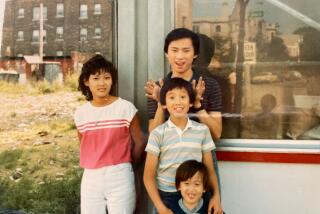A member of a musical dynasty writes a postcard about the past
It was a remarkable backyard there in Pacific Palisades, the kind that produces enduring memories -- of sloshing in the culvert under Sunset Boulevard, chewing watercress plucked from the spring-fed creek, tramping through tangled woods away from watchful eyes. It made for a childhood that was part Norman Rockwell, part Robinson Crusoe.
For years, Thomas Newman, an admired composer of movie soundtracks, has collected ephemera from the places where he romped as a boy -- faded photos, vintage postcards, cartoons and other relics of the Uplifters, a spirited bunch of Los Angeles Athletic Club movers and shakers who bought land from the Methodists in the early 1900s and created a country compound in Rustic Canyon.
FOR THE RECORD:
Thomas Newman: An article in Thursday’s Section A on film composer Thomas Newman’s creation of “It Got Dark” said the piece would be performed by the Kronos Quartet and the Los Angeles Philharmonic under the baton of Leonard Slatkin. Slatkin is recovering from a heart attack, so John Adams was the conductor. In addition, the article said John R. Neill was the original illustrator of the “Oz” books. William Wallace Denslow illustrated “The Wizard of Oz,” the first book in the series. Neill illustrated many of the subsequent books in the series. —
With microphone and recorder, Newman captured the trills of birds and insects and the gurgling of Rustic Creek.
Never far from his thoughts was the desire to create something musical from the memories, the images and the sounds.
::
Nature has often served as a muse for composers. Vivaldi had four seasons. Beethoven had his Sixth Symphony, the “Pastoral.” The Talking Heads had “(Nothing but) Flowers.”
Newman looked to Rustic Canyon, with its sycamores, sagebrush and sumac, and to the beaches of Venice and Santa Monica, their erstwhile tourist attractions immortalized in postcards and photographs.
“They are little moments in time that are just forgotten,” he says. “I wanted to put music up against the photos and other ephemera.”
And so he has. His memories and collected “time capsules” have coalesced into “It Got Dark,” a 20-minute concerto grosso incorporating sounds from the canyon and oral reminiscences of its residents. It will be performed tonight and Friday by the Kronos Quartet and the Los Angeles Philharmonic at Disney Hall.
Music was as pervasive a presence in Newman’s childhood as the wildlife outside his window. From an early age, he sensed that he would not escape the call of music, although he was gripped by insecurities.
“After the music that had been created by my family, I thought there was no way I could stack up,” says Newman, 54.
His father, the late Alfred Newman, was the longtime musical director of 20th Century Fox whose scores enlivened such classics as “Wuthering Heights,” “The Seven-Year Itch” and “How the West Was Won.” His uncles Emil and Lionel Newman were composers and conductors, as are his siblings, David and Maria Newman. Songwriter Randy Newman is his cousin.
Growing up in a musical household was “complex, wonderful and a little scary,” Thomas Newman says. “You felt like you had a place but you had to earn it.”
The Hollywood String Quartet occasionally performed at the family home on Thanksgiving. Family friends included Bernard Herrmann, a film composer who did memorable work for Alfred Hitchcock, and Ken Darby, who is credited with creating the sound of the Munchkins in “The Wizard of Oz.”
Every weekend, Newman’s mother, Martha, would herd her sons into the family’s Ford Country Squire station wagon to get them to their violin lessons in the San Fernando Valley. Newman later studied composition and orchestration at USC and Yale University. During his senior year at Yale, he met composer Stephen Sondheim, who became an early mentor. By 27, Newman was composing the score for the movie “Reckless.”
Since then he has written music for dozens of films, including “The Shawshank Redemption,” “Revolutionary Road” and “Wall-E.” He has earned Oscar nominations and won five Grammys and an Emmy.
He is known as a versatile talent who can move nimbly from drama to comedy to period pieces to animated features. Fond of experimentation, he incorporates aboriginal chants and the quirky sounds of the hurdy-gurdies, zithers and baritone ukuleles he collects. The result is distinctive, often haunting music that can be lush and melodic or stark and edgy, depending on the movie moment.
The opportunity for a change of pace presented itself last year when the Los Angeles Philharmonic began planning West Coast, Left Coast, a three-week series of concerts for Music Director Gustavo Dudamel’s inaugural season. The idea of the series is to showcase music made in and influenced by California.
“One of the most exportable forms of music this region has created is that which accompanies and supports the moving image,” Chad Smith, the Philharmonic’s vice president of artistic planning, said in an e-mail. “We knew that we wanted to commission a concert work from a major film composer and immediately approached Tom Newman.”
Newman had long thought of collaborating with the Kronos Quartet, the Philharmonic’s ensemble in residence. That, Smith said, made the structure of the work obvious -- a concerto grosso for string quartet and orchestra.
As for the inspiration, Newman had a ready source.
As he often does, Newman recently donned his hiking boots and drove his Audi sedan to Evans Road, the easy-to-miss entrance to his verdant stomping ground. Back in the day, he would arrive on the banana seat of his Sting-Ray bike, eager to caper among the California live oaks and chunky conglomerate hillsides that line Rustic Creek.
The area below Will Rogers State Historic Park is nearly as wild as when Newman and his boyhood pals left off tadpoling at the clang of their families’ dinner bells. He grew up nearby amid an avocado grove in a boatlike A-frame designed by Lloyd Wright, son of Frank Lloyd Wright.
At the end of Evans Road, he turns into the driveway of Ethel Haydon, a longtime resident who lets Newman and Randy Young, a childhood friend and local historian, cut through her property to get to the hiking trail that crisscrosses the creek. It is perhaps half a mile north of Sunset Boulevard, but the surroundings feel like pure country.
“This really does bring me back,” Newman says. “I have such memories of the end of this road.”
He points to a crude wooden structure in an old live oak, next to Haydon’s chicken coop.
“I really remember that treehouse,” he says.
Newman says Young encouraged his interest in the local landscape and history. Young introduced him to Uplifters lore and to postcard shows.
After clambering over a weathered wooden fence, the two men balance on wobbly rocks to cross the creek, which one longtime resident dubbed Sparkle-Babble-Sing-and-Sigh. Newman, whose eyes are the color of his faded denim jeans, points farther up the canyon, where a clay bank called Oo-Goo was a favorite hide-out. The name apparently derives from a story by L. Frank Baum, an early Uplifter and author of the “Oz” books. One book in the series deals with the Queen of Oogaboo’s attempt to conquer the rest of Oz. Newman owns an original cartoon by John R. Neill, the first illustrator of the “Oz” books, showing Oogaboo citizens on the march. Oo-Goo. Sparkle Babble. Uplifters.
Such memories and ephemera begot “It Got Dark,” which evokes the sudden onset of darkness after a day spent outdoors. Newman worked on the piece for a year, he says, organizing it “in a way that shed light or cast shadow over what is now versus what was then, and my unique position of seeing both at once.”
The work consists of eight short movements with titles such as “The Long Wharf” and “Crystal Plunge.” “Skipping Flat Loop (Both Feet In),” fast and energized, is named for a roping maneuver. “Glitter Mollusk” conveys a haunting sense of loss. “Rile Push Cart” was inspired by a postcard image in Newman’s collection that was shot by H.F. Rile, a beach photographer. The postcard shows a parade of tuba players and well-dressed beachgoers on a boardwalk, pushing carts of all descriptions.
As the piece progresses, loud gives way suddenly to soft. Lively and raucous shift to sad and poignant.
The composition opens with a field recording of birds and other sounds that Newman made in Upper Rustic Canyon in 1995. The movements are interspersed with segments from oral histories of departed canyon notables: Emil Sandmeier, humorist Will Rogers’ longtime “man Friday,” who talks of cutting through the canyon to get to Rogers’ ranch, and Virginia Benton, who is heard reciting her poem “The Stairs.”
Writing the Philharmonic-Kronos piece was freeing compared with composing for film, and involved much experimentation, Newman says.
“You’re not bound to a certain amount of seconds of action or drama,” he says. “You let your mind wander in a much different way.”
His neat-as-a-pin studio, next to the home he shares with his wife, Ann Marie, and three children, is in a tree-shaded cul-de-sac a short distance from where he grew up. The front room is dominated by a 1928 Steinway & Sons piano that his father would plunk while using a stopwatch to match his musical interludes to cinematic scenes. Nearby are instruments familiar and exotic -- electric guitars, brass singing bowls and African thumb harps.
When Newman visited the Kronos Quartet’s San Francisco studios to work on the piece, he took some of the instruments and all sorts of vintage sound gear. He recorded “samples” of Kronos’ playing, ran them through processing devices and came up with “ghostly phrases” that he embedded in “It Got Dark.”
“We’ve had the most amazing time with him, exploring sound,” says violinist David Harrington, the quartet’s founder. The piece, Harrington says, is “very personal.”
“There are several moments of incredible lyricism and beauty that just remain in your consciousness,” he says. “It has that elemental quality that much of his music has.”
Kronos performed a quartet version of the work at the Nov. 21 opening concert of West Coast, Left Coast. Tonight and Friday, the quartet will perform with the Los Angeles Philharmonic under the baton of Leonard Slatkin.
Some of the movements are sentimental, Newman acknowledges. How could they not be? To Newman, “It Got Dark” is “music of loss and memory.”
More to Read
Sign up for our Book Club newsletter
Get the latest news, events and more from the Los Angeles Times Book Club, and help us get L.A. reading and talking.
You may occasionally receive promotional content from the Los Angeles Times.







